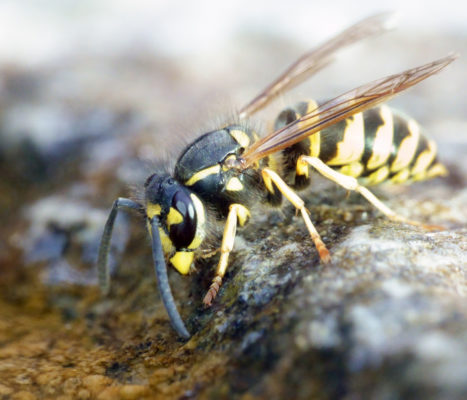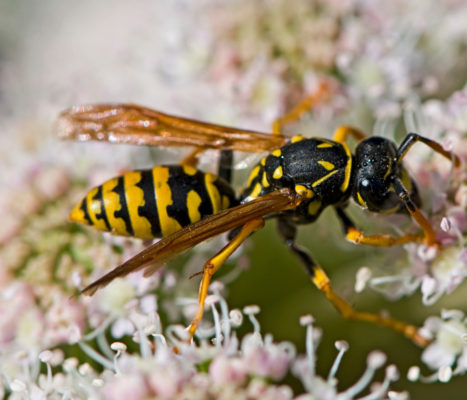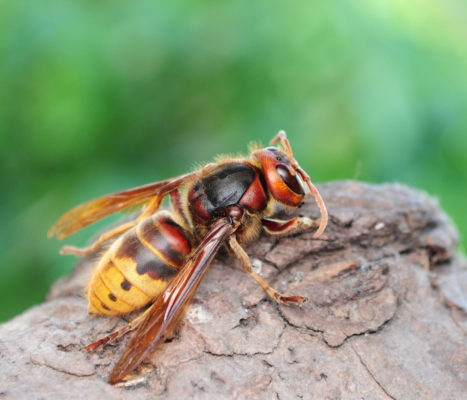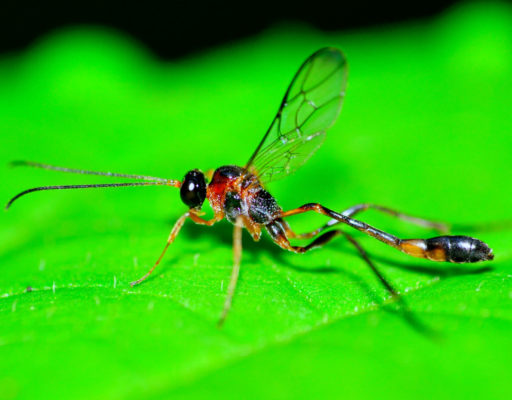Having wasps around your home is never a good feeling. Not only are wasps dangerous but they can make the outside of your home unwelcoming.
Do you need to get rid of wasps fast? You’re in the right place.
In this post, I will go over 7 ways you can get rid of wasps instantly.
Let’s dive in.
1. Use Insectcide Sprays
One way to kill wasps instantly is to spray chemical insecticides directly to where the wasp frequent.
For this, I recommend using a chemical that kills wasps on contact or has a residual effect.
One commonly used chemical against wasps is pyrethrin. Pyrethrin has a quick knockdown effect on wasps. The only downside is that it doesn’t have a residual effect.
Microencapsulated insecticides provide a residual effect that can last for as long as 3 months. This insecticide allows you to kill any wasps that land where you spray it. Microencapsulated tend to last longer and withstand harsher conditions.
Common areas to apply insecticide include plants, trees, gardens, grass, outdoor furniture, the exterior of the home. You can also spray around water sources such as pools and fountains.
2. Use Wasp Traps
Wasp traps are quite simple to make but are very effective. Keep in mind that these traps are not meant to eliminate a wasp infestation. They are more for removing wasps that are flying around your home.
You can either use a DIY trap or purchase a pre-made trap online or in-store for this method.
Although buying a trap may be more costly, it allows you to release the wasps if you want to. The DIY method, on the other hand, is designed to kill any wasps trapped inside.
To do it yourself, all you need is a 2-liter bottle. Then, cut the top off of the bottle so what remains in your hand looks like a funnel.
Place this funnel on top of the trap so that it functions as a funnel.
Next, place a liquid inside that will attract wasps.
In some cases, water is sufficient, but the more attractive the liquid is, the more effective the trap will be. One popular choice to use to attract wasps is diesel fuel. Wasps are highly attracted to diesel fuel. And once they enter the trap and fall inside the diesel, they are guaranteed to die.
3. Use Insecticidal Dust
Insecticidal dust kills wasps gradually, allowing you to kill wasps undisturbed.
You can apply the insecticidal dust in wasps nests using a dusting bulb. Insert the tip of the dusting bulb into the nest’s entry point. Make sure to fill the entry point with dust completely. Re-apply every 2-3 days about five times or until the entire nest is dead.
Remember to wear the proper attire before treating the nest. I recommend purchasing disposable wasp protection suits. You can get these for under $50. As an alternative, you can wear jeans, a thick jacket and a pair of gloves. You’ll also want to wear a mosquito net to protect yourself.
4. Foam or Drench Your Nest
Another effective way to eliminate wasps instantly is by drenching the nest with insecticide foam.
These commercial bee sprays come in aerosol cans. They shot foam, designed to cover the entire nest and the bees with insecticide.
You can purchase hand-held ones or the ones that come in larger containers with long nozzle sprayers. The nozzle is intended to reach large distances, allowing you to spray bees from far away.
When using insecticide spray, remember to exercise extra caution. Insecticide sprays can upset the hive and cause them to swarm.
Stand as far away from the nest as possible before spraying. Make sure to wear the proper protection before spraying the wasps. Wear jeans and a thick jacket as well as gloves. You’ll also want to wear a mosquito net to protect yourself. You can also purchase disposable bee protection suits for under $50.
5. Freeze Sprays
Freeze sprays can knock down wasps on contact. The benefit of these sprays is that they have a large spray distance, allowing you to spray a nest from around 15 feet.
Freeze spray is most effective on nests in the ground or where there is a clear entry point.
Don’t use freeze spray if you don’t have direct access to the nest. If the nest is embedded between a crack or crevice, choose a different method.
6. Perimeter Spraying
Spraying the perimeter of your house is a great way to prevent wasps from building a nest around your home.
This will kill any wasps that decide to try and land on your home or around your home.
After coming in contact with the insecticide the wasps will eventually die. Residual insecticides are more effective at first and tend to loose their effectiveness as they time passes.
When spraying, be mindful of areas where insecticide application may be harmful such as plants.
7. Call a Professional
The easiest and safest way to getting rid of wasps instantly is calling a profession is a great option.
Although wasps are not aggressive by nature, they can be when threatened. You can spare yourself the risk of getting stung by calling a professional.
If you do experience a wasps nest that is aggressive, I highly recommend you avoid them at all costs. Let the professionals deal with the situation. They will have the proper equipment to handle the aggressive wasps.
The average cost for a professional wasps removal can be as low as $100 and as high as $500.
But the price varies on the location and visibility of the nest. The harder it is to get rid of the wasps, the more expensive the removal will become.
How To Prevent Wasps
1. Seal Off Entry Points
Wasps tend to look for tight areas where they can build their nest. This is commonly in cracks, crevices, or gaps around your home.
You want to inspect the outside of your home for any potential crevices where wasps can build a nest. Common places to inspect around your home inluces:
- Window sills
- Door sills
- Eves
- Walls Sides
You can seal smaller holes and cracks using caulk. For larger cracks and crevices you can use steel wool and caulk to cover and entry points.
2. Remove Food Sources
Wasps are attracted to food. As such, one of the easiest ways to keep wasps away is by eliminating food resources.
Wasps’ diet varies from species to species. But, in general, wasps feed on protein from other insects and sugar from nectar and honeydew. They may also get their sugar by stealing honey from bees.
Yellowjackets, however, will eat human food. That’s why you’d see these wasps flying around your garbage can.
To keep wasps away, make sure to keep your trashcan lids closed. Seal any food source in airtight containers.
Maintain your yard and pick up any fallen fruits off the ground. If possible, get your plant’s protective coverings to prevent wasps from being attracted to them.
3. Eliminate trash and rotting wood
Like any pests, wasps come to your house in search of food, water and shelter. To keep them away make your home as undesirable to wasps as possible.
Limit nesting materials such as trash or rotting wood. Wasps use wood to build their nests. To do this, wasps scrape wood fiber from weathered or decaying wood and mix it with their saliva to create paper pulp.
Wasps can continue looking for wood even after their nest is built. As such, to keep wasps away, make sure to store all your wood correctly. This is especially true if you have rotting or weathered wood lying around.
Finally, apply chemical insecticide to the exterior of your home.
4. Eliminate Water Sources
Wasps need water to survive. Water sources around your home, such as pools, fountains, or puddles, can attract wasps.
To keep them away, make sure your plumbing and gutters are working correctly.
Inspect if there is any puddles forming, and make sure to remove them. Properly grade your home or add a drain to prevent this from happening.
If you have sitting water such as pools or water fountains, consider using a water disrupter to keep wasps away. Wasps prefer calm water and tends to avoid moving water.
5. Remove Dry Or Barren Soil
Wasps use dry or barren soil for building nests. They dig through dry and sandy soils, creating holes for their nest.
To avoid this, consider planting grass over dry or barren dirt. You can also consider use rock gravel or mulch to prevent wasps from digging and creating their nests.
Finally, consider applying chemical insecticide to the soil to kill any wasps that attempt to build a nest.
Types of Wasps
Yellowjacket

Yellowjackets grow to about half an inch long. However, the queen is larger, at about .75 inches long.
Yellowjackets have black and yellow bands across their bodies. This color and pattern are why Yellowjackets are often confused with bees.
Yellowjackets have stingers that can sometimes be lodged and separated from the wasps’ bodies. Besides the pain, their sting is generally harmless. However, they can be dangerous for those who have allergies.
You can find Yellow Jackets across the world. The eastern Yellowjackets live in eastern North America.
Paper Wasps

Paper wasps grow to about ¾” of an inch long. They have brown, slender bodies with yellow markings along with their head and abdomen.
Paper wasps build their nest in protected areas such as eaves, door frames, and thick vegetation. Their nest is built from plants. A finished nest looks like an upside-down umbrella with hexagonal patterns made from paper.
Hornets

Hornets grow to about an inch long. They have black, slender bodies with yellow or white stripes. They look look like and behave very similar Yellowjackets.
You can find Hornets across the world, but they are most common in the Northern Hemispere.
Mud Daubers

Mud Daubers grow to about ½ inch to an inch long. They have black, slender bodies with yellow on their legs and thorax.
Mud Daubers are native to North America, but you can find the across the world today. Unlike other wasps, Mud Daubers are solitary.
They do not swarm nor build nests with other wasps. Instead, they build nests from mud solely for their offspring. You can find Mud Daubers nests near structures.
Frequently Asked Questions (FAQ)
Does bleach kill wasps?
Yes, Bleach kill wasp. But it’s not the most effective solution against wasps. To use bleach to kill wasps, you’ll have to spray it directly on the wasp. And you’d have to spray enough of it. If you are able to accomplish this, you may need to wait a few minutes before the bleach can kill the wasp.
To use bleach to kill wasps, mix the bleach with water one to one and pour in a spray bottle. Spray the solution directly on the wasp.
Does WD-40 Kill wasps?
Yes. WD-40 is a proven method to kill wasps. Once you apply WD-40 to the wasp it kills it by suffocation.
WD-40 has an oil-based formula that can cover wasp spiracles or holes on the wasps body.
Does Vinegar Kill Wasps?
Yes, vinegar can kill wasps, but it’s not a solution I’d recommend. To kill wasps with vinegar you’ll need to be spray high volumes of it directly on wasps, which is impractical.
